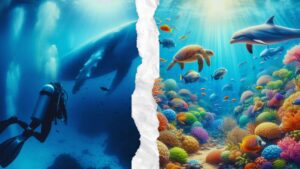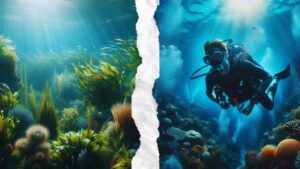The ocean, which covers more than 70% of our world, is a huge, unseen world full of life. From the small plankton to the blue whale, marine animals cover an amazing number of living things that are critical components of keeping the ecosystems of our planet healthy and in balance. We at Anee’s School feel that there should be an immense respect for nature, and students should be made to learn and discover the complex web of life under water.
The Marine Diversity
Marine animals are incredibly diverse, made up of a range of groups of organisms:
🔵 Plankton: Tiny animals, such as phytoplankton (plants) and zooplankton (animals), which are the building blocks of the marine food chain.
🔵 Invertebrates: Animals without a backbone like sponges, corals, jellyfish, mollusks (such as octopuses and squids), and crustaceans (such as crabs and lobsters).
🔵 Fish: A wide group from small gobies to big predators like sharks.
🔵 Reptiles: Sea turtles, sea snakes, and marine iguanas.
🔵 Mammals: Whales, dolphins, seals, and manatees.
🔵 Birds: Penguins, albatrosses, and seagulls that feed off the ocean.
This diverse fabric of life has been honed over billions of years, evolving to thrive in different marine environments from brightly lit coastal waters to the dark, deep waters of the abyssal zone.
Roles in the Ecosystem
Every sea creature plays its part in a way in the ecosystem:

💧 Primary Producers: Phytoplankton undergo photosynthesis, yielding oxygen and providing the foundation for the majority of sea food chains.
💧 Herbivores: Organisms such as parrotfish eat algae, which avoids overgrowth capable of smothering corals.
💧 Carnivores: Fish predators and sea mammals maintain populations of species in balance, preserving ecological harmony.
💧 Decomposers: Bacteria break down dead material, cycling nutrients back into the ecosystem.
Coral reefs, which have been called the “rainforests of the sea,” are an example of marine biodiversity. Coral reefs act as habitat, source of food and breeding place for innumerable species, harboring an estimated 25% of all marine species on less than 1% of the seafloor.
Importance of Marine Biodiversity
Marine biodiversity is important for a number of reasons:
💠 Climate Regulation: Oceans take up large quantities of carbon dioxide, and marine organisms contribute to carbon sequestration.
💠 Economic Resources: Fisheries and tourism support many communities as a source of livelihood, both of which are reliant on productive marine ecosystems.
💠 Medical Discoveries: Marine animals have provided sources of new compounds for pharmaceuticals.
💠 Cultural Significance: Oceans are of spiritual and cultural significance to many societies.
Threats to Marine Life
Though highly valuable, marine ecosystems are under many threats:

🌊 Climate Change: Heating ocean temperatures cause coral bleaching and disrupted species distributions.
🌊 Pollution: Runoff, plastic, and oil spills damage habitats and kill wildlife.
🌊 Overfishing: Unsustainable fishing exploits the fish population and guts food webs.
🌊 Habitat Destruction: Coastal development and destructive fishing practices destroy vital habitats such as mangroves and seagrasses.
Conservation Efforts
Marine biodiversity protection demands international and local efforts:
🐟 Marine Protected Areas (MPAs): Specific areas where human activity is managed to protect marine life.
🐟 Sustainable Fishing: Enforcing quotas and encouraging sustainable fishing practices.
🐟 Pollution Control: Minimizing plastic use and enhancing waste management to avoid ocean pollution.
🐟 Climate Action: Reducing greenhouse gas emissions to slow ocean warming and acidification.
Schools such as Anee’s School have an important role to play in conservation by sensitizing and motivating their students to become guardians of the marine ecosystem.
🌍 Conclusion
The ocean’s rich variety of life creates a sophisticated and interrelated web that supports our planet in countless ways. It is not merely a matter of protecting the animals down below, but of creating a healthy, balanced Earth for future generations. We at Anee’s School are dedicated to fostering this awareness, educating our students to make conscious choices and take responsible actions in favor of our oceans.
Read more important blogs from Anee’s School:
Engaging Learning Through Storytelling | Anee’s School








